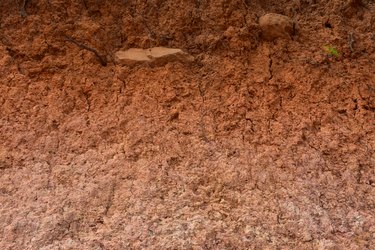
Heavy clay, red or otherwise, is inhospitable to most plant life, but there are things you can do to make sure that your property has a healthy green lawn. Follow some basic steps to make grass grow on red clay soil and establish a lush lawn that is the envy of the neighborhood.
How to Make Grass Grow in Red Clay Soil
Video of the Day
Step 1: Put on Protective Gear
Put on a dust mask, safety glasses, gloves, closed-toe shoes and other safety gear before working with power and hand tools, soil, soil amendments, compost and fertilizer. In addition, avoid working with clay soils when they are hard as a rock or soaking wet. Either condition makes red clay extremely difficult to work with; wait until the soil is almost dry — but not quite.
Video of the Day
Step 2: Clear Weeds and Grass
Remove all the existing weeds and grass from the area to be seeded. This can be done with a tiller, a nonselective herbicide or by hand weeding. Grass is not a strong competitor against many weeds, so getting the roots out is critical.
Step 3: Rake and Loosen the Soil
Rake the area so that it is cleared of rocks and pebbles, which not only impede the grass seed from making contact with the soil but make an uncomfortable surface to walk on. If you are using a tiller, lightly run the machine over the area to loosen the upper 3 or 4 inches. Rake the area again to fill in any low areas and to make the total area as flat as possible.
Step 4: Amend With Lime
Add lime, if needed, according to the results of a soil test. Most areas that have red clay also have a low pH level. Lime will adjust this by neutralizing the soil and making a better overall environment for the grass to thrive. Read the instructions carefully and consult your local extension service if you have questions.
Step 5: Add Compost to Clay Soils
Consider adding organic matter — but not sand, which will turn already-hard clay into an even-harder brick-like substance. The term clay, whether it is referring to southern red clay or Midwest gray clay, is a description of particle size. Tiny particles of soil are held together tightly and, like flour in a box, there is no space for air between the particles. Grass roots, particularly seedling roots, need those spaces to push through and reach nutrients.
Adding a layer of compost to the area will help create those important gaps. Compost contains large angular particles, which, like ping-pong balls in a tube, will allow lots of air between them. Compost helps lighten the soil, but sand fills the tiny gaps, resulting in a concrete-like surface. Spread a 2- to 4-inch layer of compost over the area and lightly till to incorporate the compost into the soil surface.
Step 6: Sow the Grass Seed
Sow the grass seed. The rate of application is stated on the mix. Using a spreader or other means to disperse the seed, divide the rate of application in half. Walk up and down the area spreading your seed.
When the first half of seed is gone, you should have covered the entire area. With the second half of the mix, walk back and forth across the area, spreading seed as you go. As this seed is being dispersed perpendicular to the first half, you will get a more even overall application.
Step 7: Cover With Straw Mulch
Cover the seed with a light layer of straw. This will help keep the moisture on the surface of the soil, where the seeds need it to germinate, rather than letting the moisture evaporate. Straw mulch will also help keep the soil temperature down, particularly on hot, sunny days.
Step 8: Water Until Seeds Germinate
Water the whole area well. To germinate, seeds need to have constant moisture, so frequent, short watering spells are better than one long session. When the grass is mature and you are establishing a good root system, then longer, deeper watering is recommended. If the weather does not supply rainfall, you will need to set your watering timer to twice or even three times every day.
Morning and evening are the best times to water, but hot afternoon sun can bake the ground, including the seed, very quickly. Most of the seeds should germinate in about two weeks or less. Some varieties do take longer, though, so check the seed packaging for normal germination times.
Step 9: Mow the New Grass
Let the grass grow to about 3 inches, and then give it a light mow when the weather is dry. Cutting wet grass, particularly newly sown lawns, will cause the tiny roots to be torn up. Avoid removing more than one-third of the grass blade. Leave the clippings on the lawn to decompose and return their nutrients to the soil.
Step 10: Remove the Straw Mulch
Remove the straw mulch after the first mowing. If the mulch was light, with at least one-half of the bare soil exposed, you might leave the straw to decompose. At approximately four weeks after the grass seeds germinate, lightly fertilize your grass with a high-nitrogen fertilizer to nourish it.